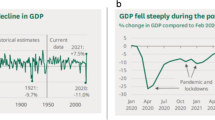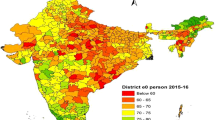Abstract
Aim
The public health sector in Brazil covers approximately 75% of the population, yet accounts for just 45% of total health expenditure, while the private sector, covering 25%, spends 55% of the resources. The objective of this study, therefore, was to estimate the effectiveness of public and private health activities in Brazil.
Subject and methods
The study uses data from the time period covering 2008 to 2015, a period when there was considerable economic growth and also an expansion of private health insurance. Using data from 5568 municipalities, the logarithmic linear multivariate regression model was used to estimate the impact of the two sectors on infant, maternal, and preventable diseases mortality rates from 5 to 74 years of age.
Results
The data showed that in public basic care, the number of public treatments increased 55% in medium complexity cases and 36% in high complexity cases, while private expansion was 19% and 18%, respectively. For hospital admissions, the public sector expanded by 9% in medium complexity cases and 21% in high complexity cases, while private sector admissions decreased by 18% and 43%, respectively. In terms of impact, the number of child deaths fell by approximately 13%. The estimate suggests that, with a 95% confidence interval, an increase of one public establishment per thousand inhabitants reduces, on average, by 189.4% the infant, maternal, and preventable disease mortality rates from ages 5 to 74 years, whereas an additional private establishment per thousand beneficiaries reduces the above mortalities by just 1.9%.
Conclusion
Underfinancing of public sector health services seems to be the central issue for the development of better public health outcomes in Brazil.
Similar content being viewed by others
References
ANS (2020) Beneficiários de planos privados de saúde, por cobertura assistencial (Brasil – 2010-2020). Agência Nacional de Saúde. Available online at: https://www.ans.gov.br/perfil-do-setor/dados-gerais. Accessed 8 Apr 2020
Arrow KJ (1963) Uncertainty and the welfare economics of medical care. Am Econ Rev 53:941–973
Bain JS (1956) Barriers to new competition. Harvard University Press, Cambridge
BM (2017) Um Ajuste Justo análise da eficiência e equidade do gasto público no Brasil. Vol 1 (síntese) World Bank Group, Washington, DC
CFM (2017) Em cinco anos, Brasil perde 23,6 mil leitos de internação no SUS. Conselho Federal de Medicina. Available online at: https://portal.cfm.org.br/index.php?option=com_content&view=article&id=26171:2016-05-17-12-26-58&catid=3. Accessed 13 Aug 2018
Dain S (2001) O financiamento público na perspectiva da política social. Revista Economia e Sociedade, 17. Campinas: IE-Unicamp
Dedecca CS (2008) O trabalho no setor saúde. São Paulo em Perspectiva 22:87–103
GB (2019) Brasil registra aumento no número de transplantes mais difíceis de serem realizados. Governo do Brasil. Available online at: https://www.saude.gov.br/noticias/agencia-saude/45850-brasil-registra-aumento-no-numero-de-transplantes-mais-dificeis-de-serem-realizados. Accessed 5 Apr 2020
Gragnolati M et al (2013) Twenty years of health system reform in Brazil: an assessment of the Sistema Único de Saude. Directions in development: Washington DC World Bank. Available online at: http://documents.worldbank.org/curated/en/909701468020377135/Twenty-years-of-health-system-reform-in-Brazil-an-assessment-of-the-sistema-unico-de-saude. Accessed 1 Mar 2019
IPEA (2018) Desafios da Nação. Comunicados Instituto de Pesquisa de Economia Aplicada volume 1 Brasília
Kerstenetzky CL (2012) O estado do bem-estar social na idade da razão: a reinvenção do estado social no mundo contemporâneo. Elsevier, Rio de Janeiro, RJ
Lábaj M, Silanič P, Weiss C et al (2018) Market structure and competition in the healthcare industry. Eur J Health Econ 19:1087–1110. https://doi.org/10.1007/s10198-018-0959-1
Massuda A et al (2018) The Brazilian health system at crossroads: progress, crisis and resilience. BMJ Glob Health. https://doi.org/10.1136/bmjgh-2018-000829
Mendes EV (2011) As Redes de Atenção à Saúde. Brasília: Organização Pan-Americana da Saúde. Available online at: http://bvsms.saude.gov.br/bvs/publicacoes/redes_de_atencao_saude.pdf. Accessed 1 Jun 2018
Mendes Á (2015) Limite de Gasto com Pessoal na Saúde pela LRF: uma barreira à construção do SUS público, integral e de qualidade. Domingueira da Saúde do Idisa Campinas 5:1–4
MS (2009) Glossário Temático Economia da Saúde. Brasília: Secretaria-Executiva. Brasília: Secretaria de Ciência, Tecnologia e Insumos Estratégicos. Available online at: http://bvsms.saude.gov.br/bvs/publicacoes/glossario_ecos2.pdf. Accessed 15 Nov 2018
Ocké-Reis CO (2008) Os problemas de gestão do SUS decorrem também da crise crônica de financiamento? Trabalho, Educação e Saúde 6:613–622
Ocké-Reis CO (2012) SUS o desafio de ser único. Fiocruz, Rio de Janeiro
OECD (2017) Tackling Wasteful Spending on Health. The Organisation for Economic Co-operation and Development Publishing, Paris
Paim JS (2018) Sistema Único de Saúde (SUS) aos 30 anos. Ciencia & Saude Coletiva 23:1723–1728
Santos et al (2018) Contas do SUS na perspectiva da contabilidade internacional: Brasil, 2010–2014. Ministério da Saúde, Fundação Oswaldo Cruz 1:118
Silva LMO (2006) Organização e relações de trabalho no setor de serviços de saúde brasileiro. Dissertation, Universidade Estadual de Campinas
Stuckler D, Basu S (2013) The body economic: why austerity kills - recessions, budget battles, and the politics of life and death. Basic Books, New York
UNAIDS (2010) Outlook Report 2010: state of the AIDS response. The Joint United Nations Programme on HIV/AIDS. Available online at: http://data.unaids.org/pub/outlook/2010/20100713_outlook_report_web_en.pdf. Accessed 9 Aug 2018
Viana ALd’ (2008) Financiamento da saúde: impasses ainda não resolvidos. Trabalho, Educação e Saúde 6:599–612. https://doi.org/10.1590/S1981-77462008000300011
Viana ALd’, Lima LD (2011) Descentralização, regionalização e instâncias intergovernamentais no Sistema Único de Saúde. In: Viana ALd’, Luciana DL (org) Regionalização e relações federativas na política de saúde no Brasil, 1ª ed Contra Capa, Rio de Janeiro, pp 39–63
Viana ALd’ et al (2017) Política de regionalização do SUS em debate: avanços e impasses da implementação das regiões e redes no Brasil. Novos Caminhos: Pesquisa Política, Planejamento e Gestão das Regiões e Redes de Atenção à Saúde no Brasil, São Paulo: Região e Redes n 15
Vieira FS (2016) Reflections on the role of health economics units regarding national health care systems. Saúde e Sociedade 25(2):306–319. https://doi.org/10.1590/S0104-12902016154831
WB (2015, September 22). A marca do SUS. The World Bank. Available online at: http://www.worldbank.org/pt/news/opinion/2013/12/20/brazil-sus-unified-public-healthcare-system-new-study. Accessed 13 Jun 2018
Williams RFG, Doessel DP (2017) The economics of mental health care: industry, government and community issues. Ashgate, Aldershot
Wooldridge JM (2012) Introductory econometrics: a modern approach. South-Western Cengage Learning, Mason
Acknowledgements
The authors wish to thank the staffs of OMS, and especially at/OMS, and especially at Departamento de Economia da Saúde, Investimento e Desenvolvimento (DESID) of Ministério da Saúde do Brasil for the support in developing the work. The authors would specifically like to thank Humberto Miranda, Ana Luíza Matos, Lucas Andrietta, Gustavo Zullo, Eduardo Rao, Fábio Padua, Leonardo Nunes, Valter Palmieri, Tomás Taulois, Daniel Sampaio, Paola Zucchi, Maykon Andersom, Luiz Zazeri, Alejandra Carrillo, Clementina Corah, Maciene Silva, Maria Eridan, Carlos Sousa Cadu, Marcelo Castro, Márcio Castro, and James Lazou. We also thank the CAPES – Coordenação de Aperfeiçoamento de Pessoal de Nível Superior (Coordination of Improvement of Higher Education Personnel) for supporting the work.
Funding
Coordenação de Aperfeiçoamento de Pessoal de Nível Superior (Coordination for the Improvement of Personnel in Higher Education, CAPES).
Author information
Authors and Affiliations
Corresponding author
Ethics declarations
Conflict of interest
The authors declare that they have no conflict of interest.
Ethics approval and consent to participate
Not applicable.
Consent for publication
Not applicable.
Additional information
Publisher’s note
Springer Nature remains neutral with regard to jurisdictional claims in published maps and institutional affiliations.
Key messages (highlights)
The number of public and private treatments increased in Medium Complexity and High Complexity; the hospital admissions are higher at Medium Complexity for the public, while private ones are for High Complexity; as estimated, the model data suggest that the public health sector is twice as effectiveness as the private sector.
Rights and permissions
About this article
Cite this article
da Silva Barbosa, R., Fagnani, E. The unified health system of Brazil and the effectiveness of health services. J Public Health (Berl.) 30, 1273–1283 (2022). https://doi.org/10.1007/s10389-020-01404-x
Received:
Accepted:
Published:
Issue Date:
DOI: https://doi.org/10.1007/s10389-020-01404-x




